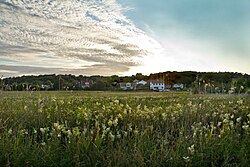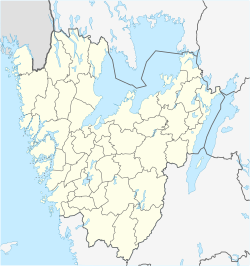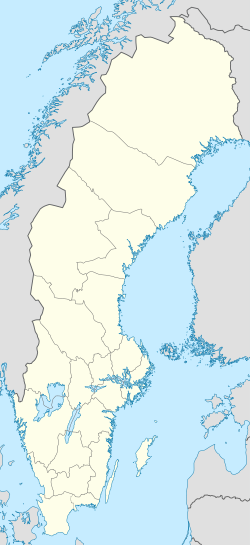Brännö is an island in the Southern Göteborg Archipelago and a locality situated in Göteborg Municipality, Västra Götaland County, Sweden. It had 708 inhabitants in 2010[1] and belongs to the parish of Styrsö within Gothenburg Municipality.
Brännö | |
|---|---|
 A field close to the center of the island | |
| Coordinates: 57°39′N 11°47′E / 57.650°N 11.783°E | |
| Country | Sweden |
| Province | Västergötland |
| County | Västra Götaland County |
| Municipality | Gothenburg Municipality |
| Area | |
• Total | 0.87 km2 (0.34 sq mi) |
| Population (31 December 2010)[1] | |
• Total | 708 |
| • Density | 813/km2 (2,110/sq mi) |
| Time zone | UTC+1 (CET) |
| • Summer (DST) | UTC+2 (CEST) |
History
editDue to its geographical location, Brännö has throughout the centuries been a strategic location for seafarers and chieftains, from both Sweden and the adjacent Norway and Denmark.
It is believed that its inhabitants are the same as the Brondings who are referred to in the Anglo-Saxon poems Beowulf and Widsith. Beowulf, England's national epic, relates that Breca the Bronding was the childhood friend of the hero Beowulf and Widsith tells that Breca later was the lord of the Brondings.
Brännö is mentioned in the Icelandic Sagas as the location of several important thing assemblies in the Viking Age and later.[2]
During the Viking Age, Brännö played a role in the international Viking slave trade between Europe and the Muslim world. People taken captive during the Viking raids in Western Europe, such as Ireland, could be sold to Moorish Spain via the Dublin slave trade[2] or transported to Hedeby or Brännö and from there via the Volga trade route to Russia, where slaves and furs were sold to Muslim merchants in exchange for Arab silver dirham and silk, which have been found in Birka, Wollin and Dublin;[3] initially this trade route between Europe and the Abbasid Caliphate passed via the Khazar Kaghanate,[4] but from the early 10th-century onward it went via Volga Bulgaria and from there by caravan to Khwarazm, to the Samanid slave market in Central Asia and finally via Iran to the Abbasid Caliphate.[5] The Laxdæla saga relates that the beautiful Irish princess Melkorka was sold as a thrall to the Icelandic chieftain Hoskuld Dala-Kollsson, during a fair on Brännö, in the 10th century.[6]
The jetty on the island is also mentioned in the song De' ä' dans på Brännö brygga.
References
edit- ^ a b c "Tätorternas landareal, folkmängd och invånare per km2 2005 och 2010" (in Swedish). Statistics Sweden. 14 December 2011. Archived from the original on 27 January 2012. Retrieved 10 January 2012.
- ^ "The Slave Market of Dublin". 23 April 2013.
- ^ The New Cambridge Medieval History: Volume 3, C.900-c.1024. (1995). Storbritannien: Cambridge University Press. p. 91
- ^ The World of the Khazars: New Perspectives. Selected Papers from the Jerusalem 1999 International Khazar Colloquium. (2007). Nederländerna: Brill. p. 232
- ^ The New Cambridge Medieval History: Volume 3, C.900-c.1024. (1995). Storbritannien: Cambridge University Press. p. 504
- ^ Karras, R. M. (2012). Unmarriages: Women, Men, and Sexual Unions in the Middle Ages. USA: University of Pennsylvania Press, Incorporated. p.102
External links
edit- Note 1: The Anglo-Saxon Dictionary, the posthumous dictionary by Joseph Bosworth (1898), see bróc - brot[permanent dead link]
- Note 2: (in Swedish) Brännö History Local fan site dedicated to Brännö (in Swedish)

